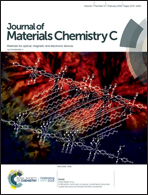Centrosymmetric Li2NaN: a superior topological electronic material with critical-type triply degenerate nodal points†
Abstract
It has been, for the first time, reported that centrosymmetric Li2NaN is a realistic triply degenerate nodal point (TDNP) material with three superior characteristics. In the band structure of the centrosymmetric Li2NaN material, there is only a single pair of TDNPs at the Fermi level and not coexisting with other extraneous bands, which indicates that the unique physical properties of the topological semimetal can be clearly detected via experiments and the Li2NaN material is an ideal TDNP semimetal. More importantly, the TDNPs identified in the Li2NaN material show an unusual critical-type band crossing, which is different from previously reported ones. Under lattice strain, we show that the positions of the TDNPs can be tuned, and the TDNPs can even be annihilated. Upon increasing the spin–orbit coupling, the centrosymmetry in the material makes the TDNPs transform into a pair of critical-type Dirac points, which are different from those in noncentrosymmetric systems. So, the centrosymmetric Li2NaN material is considered to be a superior topological semimetal with an ideal band structure, clear topological signs of physical properties, the novel pair of Dirac points and TDNPs.



 Please wait while we load your content...
Please wait while we load your content...